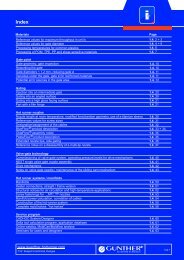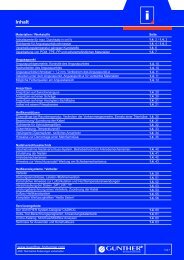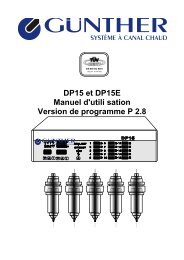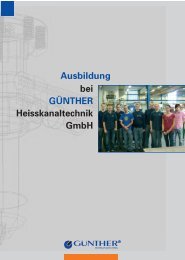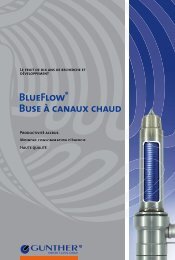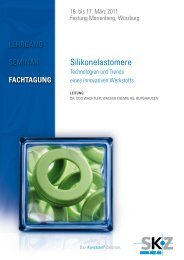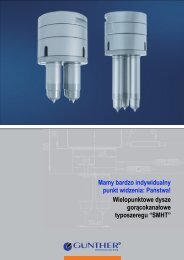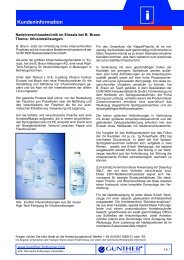Heißkanaldüsen Typ SLT/-DLT Customer information
Heißkanaldüsen Typ SLT/-DLT Customer information
Heißkanaldüsen Typ SLT/-DLT Customer information
Create successful ePaper yourself
Turn your PDF publications into a flip-book with our unique Google optimized e-Paper software.
<strong>Heißkanaldüsen</strong> <strong>Customer</strong> <strong>information</strong> <strong>Typ</strong> <strong>SLT</strong>/-<strong>DLT</strong><br />
Hot-Runner Systems for High Injection Speeds<br />
When Speed Counts<br />
When delicate parts with thin walls and long flow parts<br />
are required, quick injections are essential for reliable<br />
production processes. Rapid injection processes are<br />
often indispensable for large-volume parts too however.<br />
An adapted hot-runner technology allows perfect<br />
processes and products here.<br />
Even in conventional injection moulding processes high<br />
injection speeds are often necessary but there are two<br />
variants that set particularly high standards: expansion<br />
injection moulding and physical foaming. In expansion<br />
injection moulding the melt is compressed in the screw<br />
antechamber or in the hot-runner and used as a pressure<br />
storage medium. As shown in the PVT diagram, the<br />
plastic melt can be compressed approximately 10 % at a<br />
pressure of about 2000 bar. This behaviour is used<br />
during expansion injection moulding. It is necessary for a<br />
reproducible process however that the pre-compressed<br />
melt volume be kept constant. For that purpose the<br />
screw must be held in an exact position after<br />
compression because it would otherwise be subjected to<br />
high pressure at the opening of the valve gate nozzle and<br />
an excessive amount of melt would enter the mould. This<br />
pre-condition is satisfied by electromechanically driven<br />
injection moulding machines, permitting an optional axial<br />
positioning within the system's confines and the<br />
maintenance of this position even under high pressure.<br />
If a hot-runner system is used in expansion injection<br />
moulding, a pressure of up to 2500 bar is built up and<br />
maintained for a defined time. This ensures an even<br />
pressure in all cavities.<br />
For the successful use of expansion injection moulding,<br />
an absolutely even opening of the needles is essential.<br />
Once the needles open, the melt that is precompressed<br />
in the hot-runner can expand like an explosion and fill the<br />
cavities evenly, allowing very thin-walled components to<br />
be filled.<br />
In physical foaming, for example with the MuCell<br />
process, the system is fed a physical blowing agent,<br />
which first dissolved in the melt under pressure. On<br />
injection into the cavity, the pressure reduces, the<br />
blowing agent expands and the melt foams. Here too it is<br />
necessary to be able to inject the melt at high speeds into<br />
the cavity in order to be able to foam the part selectively<br />
in the cavity. A light-weight component with a closed<br />
outer skin and foamed core emerges. This process can<br />
produce foam structures with walls thinner than one<br />
millimetre.<br />
www.guenther-hotrunner.com<br />
7/12 Subject to technical changes<br />
iA<br />
The internal pressure that arises as a result of the<br />
foaming process acts on all points of the component,<br />
whereby to a certain degree it takes over the task of the<br />
holding pressure and in this way can balance out or at<br />
least reduce sink marks, shrinkage and warpage.<br />
For both processes the injection moulding machines<br />
must be adapted to the altered requirements. In<br />
expansion injection moulding an electric injection<br />
moulding machine is necessary for a precise dosage and<br />
injection. The MuCell process requires a special screw<br />
and special units in order to be able to inject the blowing<br />
agent in the super-critical state into the melt. Both<br />
processes – with just a few exceptions – can be<br />
conducted with all common polymers. LCP cannot be<br />
processed with the MuCell method but it is very suitable<br />
for expansion injection moulding.<br />
Valve gate systems essential<br />
In both processes valve gate hot-runner systems must<br />
be used in order to build up and maintain the required<br />
pressure in the hot-runner system. In expansion injection<br />
moulding the hot-runner system not only has to<br />
withstand very high levels of pressure, it must also be<br />
ensured that all needles in a multi-cavity mould open<br />
exactly and simultaneously. This even needle movement<br />
enables a lifting plate, which works in accordance with<br />
the principle of the sliding plate mechanism. Here the<br />
hydraulic piston's axial movement is guided through<br />
connecting links into the plate's lifting movement and<br />
accordingly causes the needles to move.<br />
Fig. A slide lock, pneumatically or<br />
hydraulically actuated by means<br />
of an external cylinder, allows the<br />
simultaneous actuation of all<br />
needles<br />
For any questions, please contact our Application Engineering department at + 49 (0) 6451 5008-31 or -63.<br />
The <strong>information</strong> is given in accordance with our present-day knowledge and is meant to provide technical background.<br />
1.5. 19



